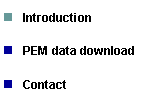

|
Introduction |

|
Web supplement accompanying:
Paired-End Mapping Reveals Extensive Structural Variation in the Human Genome Korbel et al., Science, 27 September 2007 (10.1126/science.1149504). |
|
Structural variation of the genome, involving large (kilo- to mega-base sized) inversions, deletions, and insertions (both of the latter are also known as copy-number variants, or CNVs), is widespread in healthy individuals; structural variants (SVs) are thought to causes significant phenotypic variation. Several recent studies have focused on SVs/CNVs; however cost-effective methods for comprehensively analyzing SVs at near kilobase resolution and for identifying the breakpoints of SVs have been lacking.
Thus, we developed high-resolution and massive Paired-End Mapping (PEM), which revealed extensive SV in the human population, and by determining their breakpoint junctions enabled us to analyze the extent of SVs in humans (i.e. how they affect genes), and to identify mechanisms of SV formation. SVs were identified by combining rescue and capture of the paired-ends of 3 kb genome fragments, 2nd generation (454) DNA sequencing, and a computational approach that maps DNA reads onto the human reference genome. Subsequent sequencing of breakpoint junctions allowed us to infer the origin of SVs, which are formed through non-homologous end-joining, retrotransposition, and non-allelic homologous recombination; in some instances, additional mechanisms may have been involved.
We also recently developed HighRes-CGH, a method that uses high-density oligonucleotide tiling arrays and enabled us to identify CNVs and their associated breakpoints at near-bp resolution (Urban et al., PNAS, 21 March 2006, 103:4534-9). Furthermore, for scoring the data, we developed BreakPtr, an algorithm that accurately maps CNVs by statistically integrating DNA sequence characteristics and HighRes-CGH data (with a bivariate hidden Markov model; see Korbel et al., PNAS, 12 June 2007, 104:10110-5).
Last update: 27 Sept 2007, Jan Korbel. |